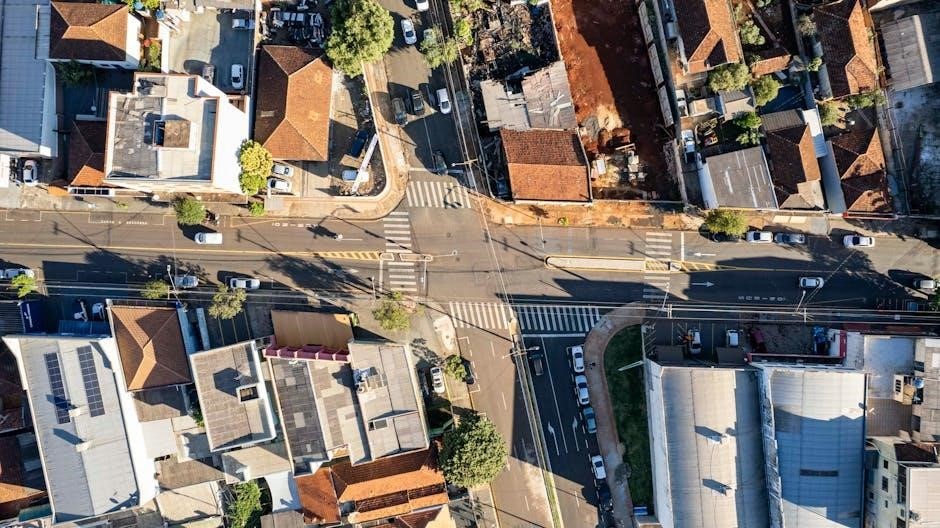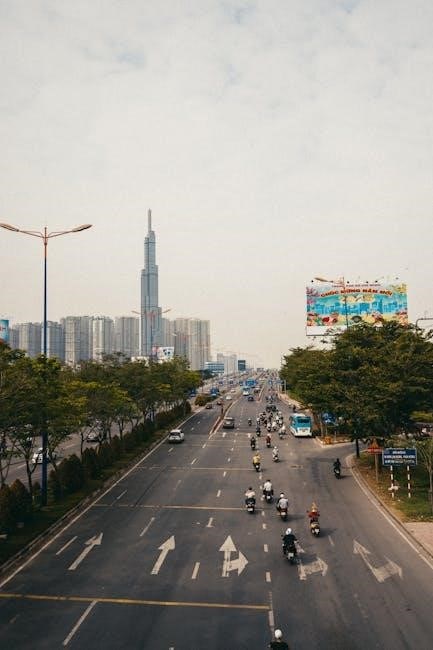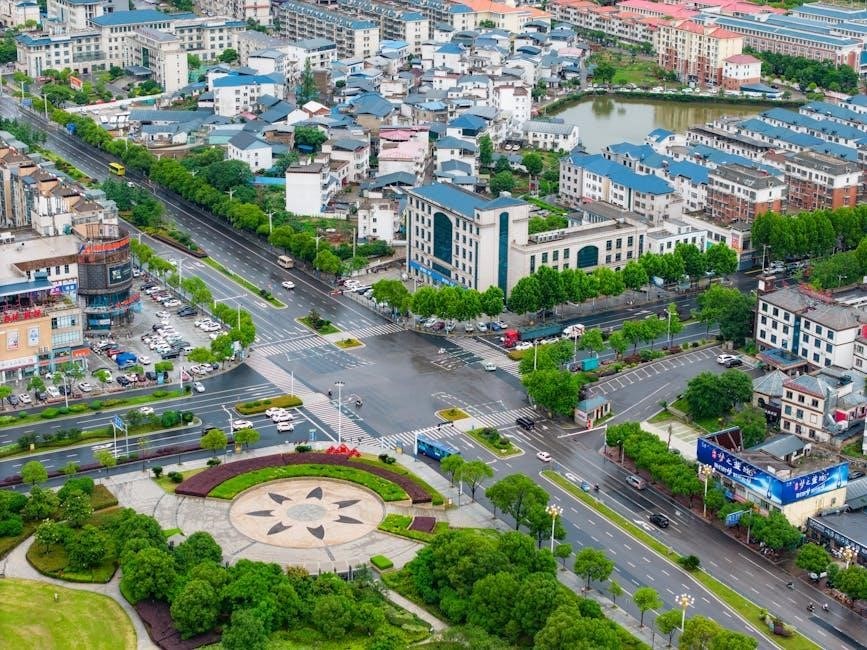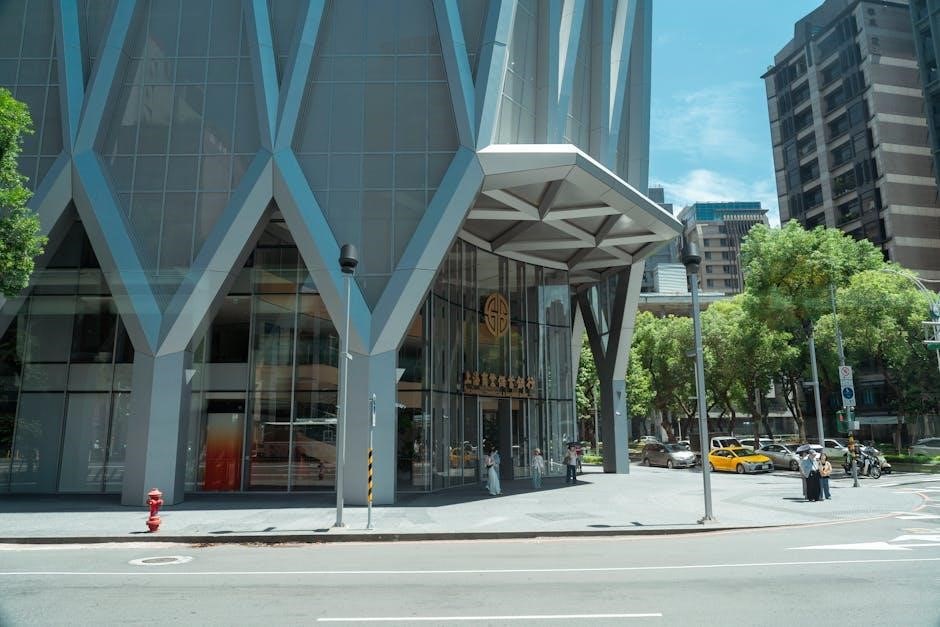The Guide to Traffic Generating Developments is a key resource for understanding and addressing the traffic impacts of new developments, providing frameworks for assessment and mitigation strategies․
What is a Traffic Generating Development?
A Traffic Generating Development refers to any land use or infrastructure project that produces significant traffic volumes, impacting surrounding road networks․ These developments, such as residential, commercial, or industrial projects, require careful assessment to understand their potential traffic generation and parking demand․ The Guide to Traffic Generating Developments provides methodologies to estimate these impacts, ensuring sustainable and efficient transportation planning․ By addressing traffic generation, the guide helps mitigate congestion and ensures that transportation infrastructure can accommodate the demands of new developments․ This framework is essential for balancing growth with mobility, fostering safer and more accessible communities․ Understanding these principles is crucial for effective urban planning and development strategies․
Purpose of the Guide
The primary purpose of the Guide to Traffic Generating Developments is to provide a comprehensive framework for understanding and managing the traffic impacts of land use developments․ It serves as a critical resource for developers, planners, and transport agencies to ensure that new projects are designed and assessed with consideration for their potential effects on road networks․ The guide offers methodologies for trip generation, parking demand estimation, and mitigation strategies to minimize congestion and enhance mobility․ By establishing consistent standards and best practices, the guide aims to balance development needs with sustainable transportation outcomes, ensuring safer and more efficient transportation systems for communities․ This resource is essential for fostering collaboration and informed decision-making in urban and regional planning contexts․

Key Considerations for Traffic Generating Developments
Key considerations include understanding trip generation rates, assessing parking demand, and conducting transport impact assessments to ensure developments align with sustainable and efficient transportation planning principles․
Understanding Trip Generation Rates
Understanding trip generation rates is crucial for assessing traffic impacts․ These rates estimate the number of trips generated by various land uses, helping planners predict traffic volume and demand․ They vary by development type, such as residential, commercial, or industrial, and are influenced by factors like location, size, and operational characteristics․ Accurate trip generation rates ensure effective traffic management and infrastructure design, minimizing congestion and optimizing mobility․
Factors Influencing Parking Demand
Parking demand is influenced by various factors, including land use type, development size, location, and accessibility to public transport․ Residential areas may require fewer parking spaces compared to commercial or retail developments․ The availability of alternative transport modes, such as buses or cycling infrastructure, also plays a role․ Additionally, operational characteristics, like business hours and peak visitor times, impact parking needs․ Understanding these factors helps in estimating demand accurately and designing efficient parking facilities․ Proper planning ensures adequate parking supply while minimizing land use and environmental impacts․ This balance is essential for sustainable urban development and traffic management․
Transport Impact Assessment Process
The Transport Impact Assessment (TIA) process evaluates the potential effects of a development on the transportation network․ It involves analyzing traffic generation, road capacity, and public transport accessibility․ The process begins with data collection, including traffic counts and trip generation rates․ This information is used to model future traffic conditions and identify potential bottlenecks․ Mitigation measures, such as improved public transport links or optimized traffic signal timings, are then proposed․ The guide provides a structured framework for conducting these assessments, ensuring alignment with land use planning and sustainability goals․ Regular updates to the guide reflect evolving transport priorities, such as multimodal integration and travel demand management․

Regulatory Framework and Standards
The Guide to Traffic Generating Developments provides regulatory frameworks and standards for assessing traffic impacts, ensuring compliance with updated policies and methodologies for sustainable development practices․
Overview of Relevant Regulations
The Guide to Traffic Generating Developments outlines essential regulations for managing traffic impacts, including trip generation rates, parking demand, and access design․ These standards ensure developments align with local transport policies and environmental goals, promoting sustainable urban growth․ Compliance with these regulations is crucial for approval and successful project implementation, balancing both public and private interests․ The guide also incorporates updates on multimodal transport and travel demand management, reflecting modern planning priorities․ By adhering to these frameworks, developers can create efficient and integrated transportation systems that support community needs while minimizing congestion and environmental impact․
Historical Development of the Guide
The Guide to Traffic Generating Developments has evolved significantly since its first release in 1991 by the Roads and Traffic Authority․ Initially focused on basic traffic generation and parking principles, it was revised in 2001 to incorporate advanced methodologies and updated regulatory standards․ In 2002, Version 2․2 was published, expanding its scope to address land-use impacts and multimodal transport considerations․ Further updates in 2013 and 2020 introduced new guidance on travel demand management and sustainable design practices․ This historical development reflects the guide’s adaptability to changing urban planning needs and its role as a cornerstone document for transport impact assessments in Australia․
Role of Transport Agencies
Transport agencies play a crucial role in the development and implementation of the Guide to Traffic Generating Developments․ They are responsible for updating the guide to reflect current methodologies, ensuring it aligns with evolving transport planning standards․ Agencies provide guidance on traffic generation, parking demand, and impact assessment, helping developers and planners meet regulatory requirements․ Their expertise ensures the guide remains a reliable resource for mitigating traffic impacts and promoting sustainable development․ By collaborating with stakeholders, transport agencies facilitate the integration of the guide’s principles into real-world applications, fostering effective traffic management and multimodal transport solutions․
Current Version Overview
The current version of the Guide to Traffic Generating Developments reflects updates to address modern transport challenges and advancements in traffic management․ It incorporates new guidance on multimodal transport impacts, site access design, and travel demand management․ The guide also features revised methodologies for trip generation and parking demand estimation, ensuring alignment with contemporary planning standards․ These updates aim to enhance the accuracy and relevance of traffic impact assessments for various development types․ By integrating the latest research and industry practices, the current version provides a comprehensive framework for sustainable and efficient traffic management in urban and regional contexts․

Assessing Traffic Impacts
Assessing traffic impacts involves evaluating how developments affect road networks, using methodologies like traffic modeling and surveys to predict future conditions and ensure sustainable planning․
Methodologies for Traffic Impact Assessment
Methodologies for traffic impact assessment involve systematic approaches to evaluate the effects of developments on transportation networks․ These include trip generation analysis, parking demand estimation, and traffic modeling to predict future conditions․ The Guide to Traffic Generating Developments outlines established techniques such as traffic surveys, capacity analysis, and simulation tools․ These methods help quantify the number of trips generated by different land uses and assess their impact on road capacity and congestion․ By leveraging historical data and forecasting models, these methodologies ensure accurate and reliable assessments, guiding developers and planners to design sustainable and efficient transportation systems․
Tools and Software Used in Assessment
The assessment of traffic impacts relies on specialized tools and software to ensure accuracy and efficiency․ Commonly used tools include transport modeling software such as VISSIM and AIMSUN, which simulate traffic flow and predict future conditions․ Trip generation models and parking demand calculators are also essential for estimating the number of trips and parking spaces required․ Additionally, geographic information systems (GIS) and data analysis platforms like Excel or Python are used to process and visualize traffic data․ These tools enable professionals to conduct comprehensive assessments, ensuring that developments align with transportation infrastructure and minimize congestion․ Regular updates to these tools reflect advancements in traffic management and planning methodologies․
Mitigating Traffic Impacts
Effective strategies for reducing traffic congestion include optimizing site design, implementing traffic management plans, and ensuring balanced access points to distribute traffic evenly․
Design and Access Considerations
Design and access considerations are critical in mitigating traffic impacts․ The Guide to Traffic Generating Developments emphasizes the importance of site layout, access point placement, and road network integration․ Proper design ensures efficient traffic flow, minimizing congestion and safety risks․ Access management strategies, such as balancing access points and optimizing driveway locations, are key to reducing traffic generation․ The guide also highlights the need for pedestrian and cyclist infrastructure to promote multimodal transport․ By adhering to these design principles, developers can create sustainable and efficient transportation systems that align with broader urban planning goals․ These considerations are essential for achieving balanced and functional development outcomes․
Effective Traffic Management Strategies
Effective traffic management strategies are vital for minimizing the impacts of traffic-generating developments․ The guide emphasizes the use of intelligent transport systems, traffic signal optimization, and real-time monitoring to enhance traffic flow․ Promoting public transport usage and encouraging non-motorized transport, such as walking and cycling, are key strategies․ Access management, including controlled entry points and shared access ways, helps reduce traffic congestion․ Additionally, travel demand management techniques, like peak-hour restrictions and ride-sharing incentives, play a crucial role․ These strategies aim to balance development needs with sustainable and efficient traffic solutions, ensuring long-term mobility and accessibility for all road users while reducing environmental impacts․

Parking and Access Design
Parking and access design are critical for managing traffic flow and ensuring safe, efficient movement within developments․ Proper planning involves estimating parking demand and designing site access points to minimize congestion and ensure smooth circulation․
Parking Demand Estimation Techniques
Parking demand estimation is a critical component of traffic generating developments, ensuring adequate parking supply while minimizing land use impacts․ Techniques include trip generation rates, parking accumulation curves, and peak demand analysis․ These methods help quantify parking needs based on development type, size, and usage patterns․ The Guide to Traffic Generating Developments provides detailed methodologies to estimate parking demand accurately, considering factors like land use, trip distribution, and modal split․ Advanced tools and software, such as trip generation models, are also recommended to refine estimates․ Proper estimation ensures efficient parking design, reducing congestion and enhancing accessibility for users, while aligning with sustainable urban planning goals․
Site Access and Circulation Planning
Site access and circulation planning are critical components of traffic generating developments, ensuring safe and efficient movement of vehicles, pedestrians, and cyclists․ Key considerations include driveway placement, visibility, spacing, and alignment with traffic signals․ The Guide to Traffic Generating Developments emphasizes designing access points to minimize congestion and reduce potential conflicts․ Circulation planning involves optimizing internal roadways to accommodate traffic flow, emergency access, and pedestrian pathways․ Proper planning also considers future growth and adaptability․ Best practices include integrating public transport stops and ensuring compliance with local regulations․ Effective site access and circulation design enhance safety, reduce delays, and support sustainable transportation outcomes, aligning with broader urban planning goals․

Travel Demand Management
Travel demand management focuses on strategies to reduce traffic congestion by promoting public transport, carpooling, and alternative modes, ensuring sustainable and efficient transportation solutions․
Strategies to Reduce Traffic Congestion
Effective strategies to reduce traffic congestion include promoting public transport usage, encouraging carpooling, and optimizing traffic signal timing․ These measures help distribute traffic more evenly, reducing bottlenecks and improving flow․
Promoting Public Transport Usage
Promoting public transport usage is a critical strategy for reducing traffic congestion․ By integrating efficient and accessible public transport options, developers can encourage a shift away from private vehicles․ This includes improving the frequency, reliability, and coverage of public transport services․ Additionally, the implementation of travel demand management techniques, such as peak-hour incentives and real-time information systems, can further enhance public transport utilization․ Ensuring that developments are designed with proximity to public transport hubs also plays a key role in reducing reliance on personal vehicles, thereby lowering traffic generation rates and alleviating congestion in urban areas․

Multimodal Transport Considerations
Multimodal transport considerations involve the effective integration of public transport, walking, and cycling options to reduce traffic congestion and promote sustainable development practices, creating a balanced and efficient transport network․
Integrating Public Transport Options
Integrating public transport options is crucial for minimizing the traffic impacts of developments․ By incorporating accessible and efficient public transport networks, developers can reduce reliance on private vehicles, lowering congestion and emissions․ The Guide to Traffic Generating Developments emphasizes the importance of proximity to bus and train stations, ensuring that public transport is a viable alternative for residents, employees, and visitors․ This approach not only supports sustainable urban growth but also enhances the overall mobility and accessibility of the development․ Effective integration requires collaboration between developers, transport agencies, and local governments to ensure seamless connectivity and optimal service levels․
Pedestrian and Cyclist Infrastructure
Pedestrian and cyclist infrastructure plays a vital role in reducing traffic congestion and promoting sustainable urban environments․ The Guide to Traffic Generating Developments highlights the importance of designing safe and accessible pathways for walkers and cyclists․ This includes dedicated bike lanes, pedestrian crossings, and well-connected walkways that encourage active transportation․ By integrating these elements, developments can reduce reliance on private vehicles, lowering traffic generation and parking demand․ Effective urban design should prioritize pedestrian-friendly and cyclist-friendly spaces, ensuring connectivity to public transport hubs and key amenities․ Such infrastructure not only enhances mobility but also contributes to healthier, more livable communities, aligning with broader sustainability goals․

Case Studies and Examples
The guide provides practical examples of traffic management strategies across residential, commercial, and industrial developments, illustrating effective implementation and assessment methodologies in real-world scenarios․
Traffic Management in Residential Areas
Effective traffic management in residential areas involves designing access points, parking solutions, and circulation systems to minimize congestion and enhance safety․ The guide emphasizes strategies like traffic calming measures, such as speed bumps and roundabouts, to reduce vehicle speeds․ Additionally, it highlights the importance of adequate parking provisions to prevent on-street parking, which can obstruct traffic flow․ Case studies demonstrate how well-planned residential developments integrate pedestrian and cyclist infrastructure, promoting a balanced transport network․ By adhering to the guide’s principles, developers ensure that residential areas remain accessible while maintaining a high quality of life for residents․ This approach aligns with broader urban planning goals, creating sustainable and livable communities․
Commercial and Industrial Development Strategies
Commercial and industrial developments require tailored strategies to manage traffic effectively․ The guide emphasizes the importance of site access design, ensuring that entry and exit points minimize congestion and align with surrounding road networks․ Parking provisions must account for employee, customer, and delivery vehicle needs, while also considering future growth․ Traffic impact assessments are crucial to predict and mitigate potential disruptions․ Additionally, the guide recommends integrating public transport options and pedestrian pathways to reduce reliance on private vehicles․ Effective traffic management strategies, such as signal coordination and peak-hour restrictions, can further enhance flow․ By implementing these measures, developers can create efficient, sustainable, and accessible commercial and industrial spaces that support economic growth while maintaining community livability․

Best Practices for Developers
Optimizing site design for traffic flow, ensuring efficient parking provisions, and engaging stakeholders effectively are key strategies outlined in the guide to minimize traffic impacts and enhance accessibility․
Optimizing Site Design for Traffic Flow
Optimizing site design for traffic flow involves strategic planning to minimize congestion and enhance accessibility․ Key considerations include logical access points, efficient parking layouts, and pedestrian-friendly infrastructure․ Designing sites to balance vehicle and pedestrian movements ensures smooth traffic circulation․ Proper land use mixing and public transport integration further reduce traffic generation․ By adhering to these principles, developers can create sustainable and functional environments that support both current and future transportation needs, aligning with the guide’s recommendations for effective traffic management and reduced urban mobility challenges․
Engaging with Stakeholders Effectively
Effective stakeholder engagement is crucial for successful traffic generating developments․ Developers must collaborate with local communities, transport agencies, and planners to address concerns and align goals․ Open communication channels, such as public consultations and workshops, ensure transparency and inclusivity․ Regular updates and feedback loops help build trust and foster cooperation․ By actively involving stakeholders, developers can identify and mitigate potential traffic impacts early, ensuring projects meet both regulatory requirements and community expectations․ This collaborative approach not only streamlines the approval process but also leads to more sustainable and accepted outcomes, as emphasized in the guide․

Future Trends in Traffic Management
Future trends emphasize technology integration, real-time data analytics, and sustainable practices to optimize traffic flow and reduce environmental impacts, as highlighted in the guide․
Technology Integration in Traffic Systems
The integration of advanced technologies, such as smart sensors, real-time data analytics, and AI, is revolutionizing traffic management․ These tools enable predictive traffic modeling, optimizing signal timing, and enhancing incident response․ The Guide to Traffic Generating Developments highlights the importance of leveraging technology to create adaptive traffic systems․ For instance, intelligent transport systems (ITS) use real-time data to manage traffic flow dynamically, reducing congestion and improving safety․ Additionally, technologies like autonomous vehicles and connected infrastructure are expected to play a significant role in future traffic management․ The guide emphasizes the need for developers to align with these technological advancements to create sustainable and efficient transportation networks․
Sustainability in Development Planning
Sustainability is a cornerstone of modern development planning, ensuring that transportation systems minimize environmental impact while meeting community needs․ The Guide to Traffic Generating Developments emphasizes the integration of sustainable practices, such as promoting public transport, cycling, and walking․ By designing developments that reduce car dependency, planners can lower emissions and enhance livability․ The guide also advocates for land-use strategies that encourage mixed-use developments, reducing the need for lengthy commutes․ Additionally, incorporating green infrastructure and energy-efficient technologies into transportation networks supports long-term sustainability goals․ These approaches ensure that traffic generating developments align with broader environmental and social objectives, creating balanced and resilient communities for the future․
The Guide to Traffic Generating Developments provides a comprehensive framework for assessing and mitigating the traffic impacts of land use developments․ By offering practical tools, methodologies, and best practices, it enables developers and planners to create sustainable and efficient transportation systems․ The guide emphasizes the importance of balancing development needs with environmental and social considerations, ensuring that traffic generation is managed effectively․ Its focus on multimodal transport integration and travel demand management supports long-term sustainability․ By adhering to the principles outlined in this guide, stakeholders can achieve harmonious and functional urban environments that prioritize accessibility, safety, and environmental stewardship․
